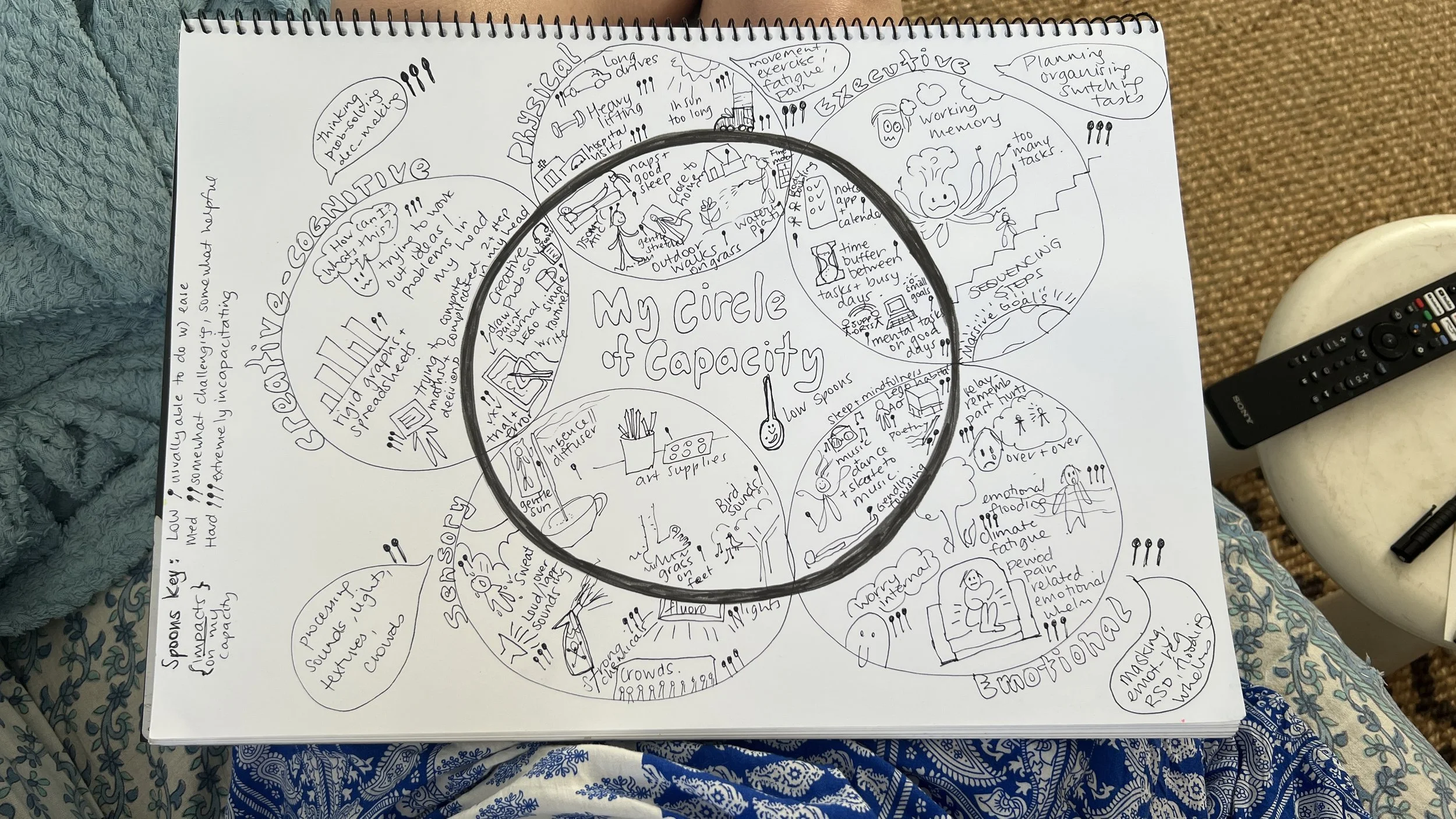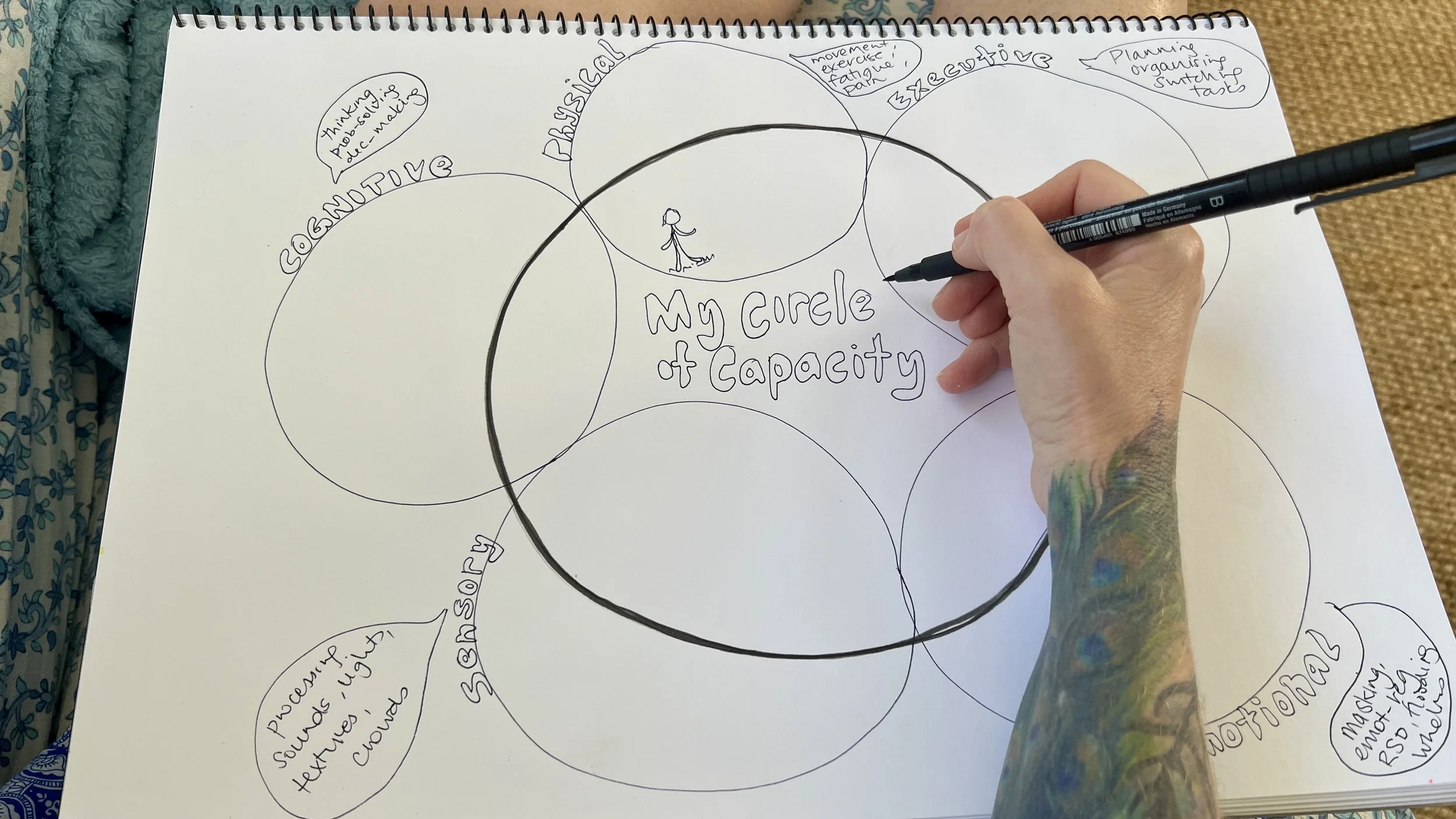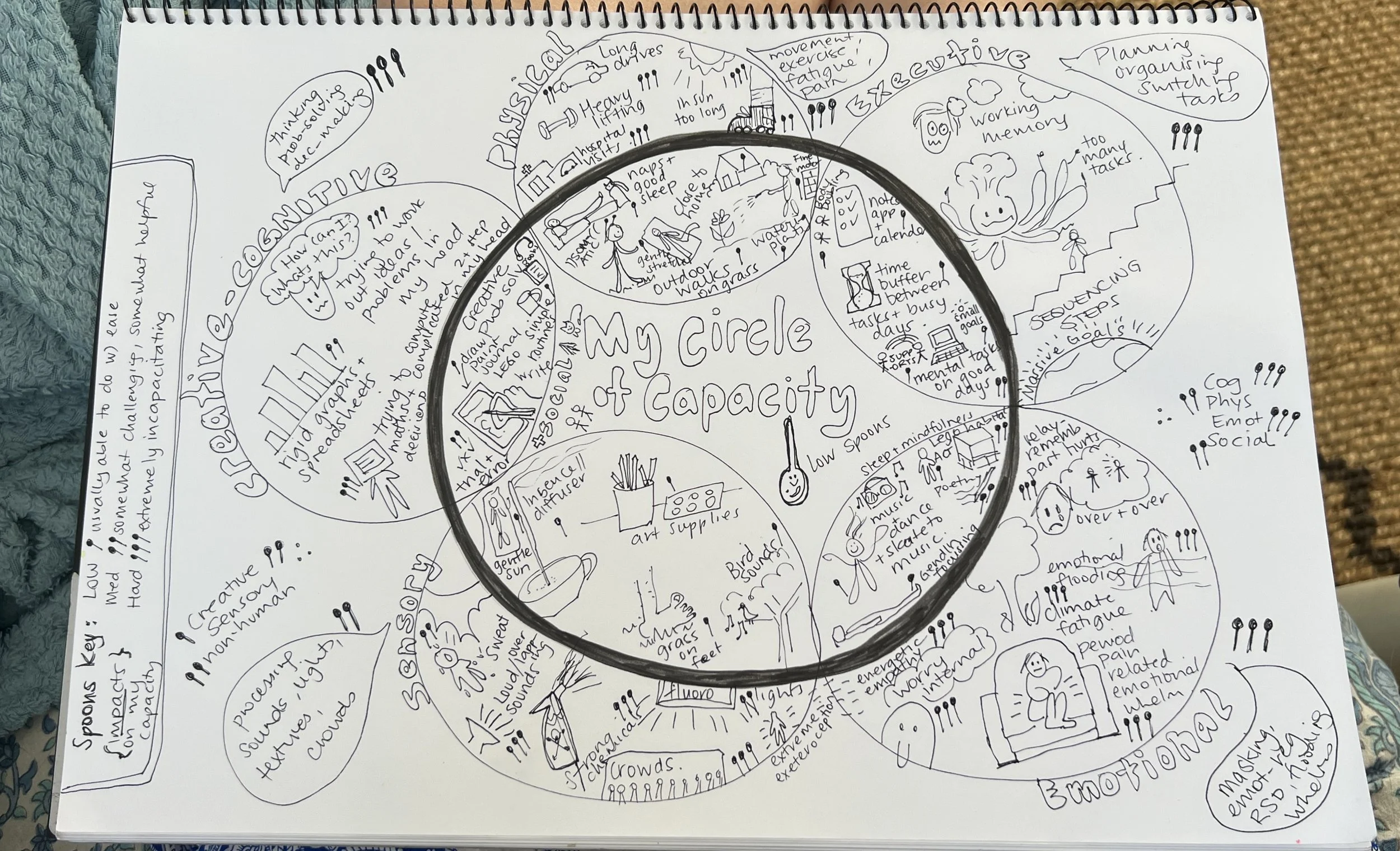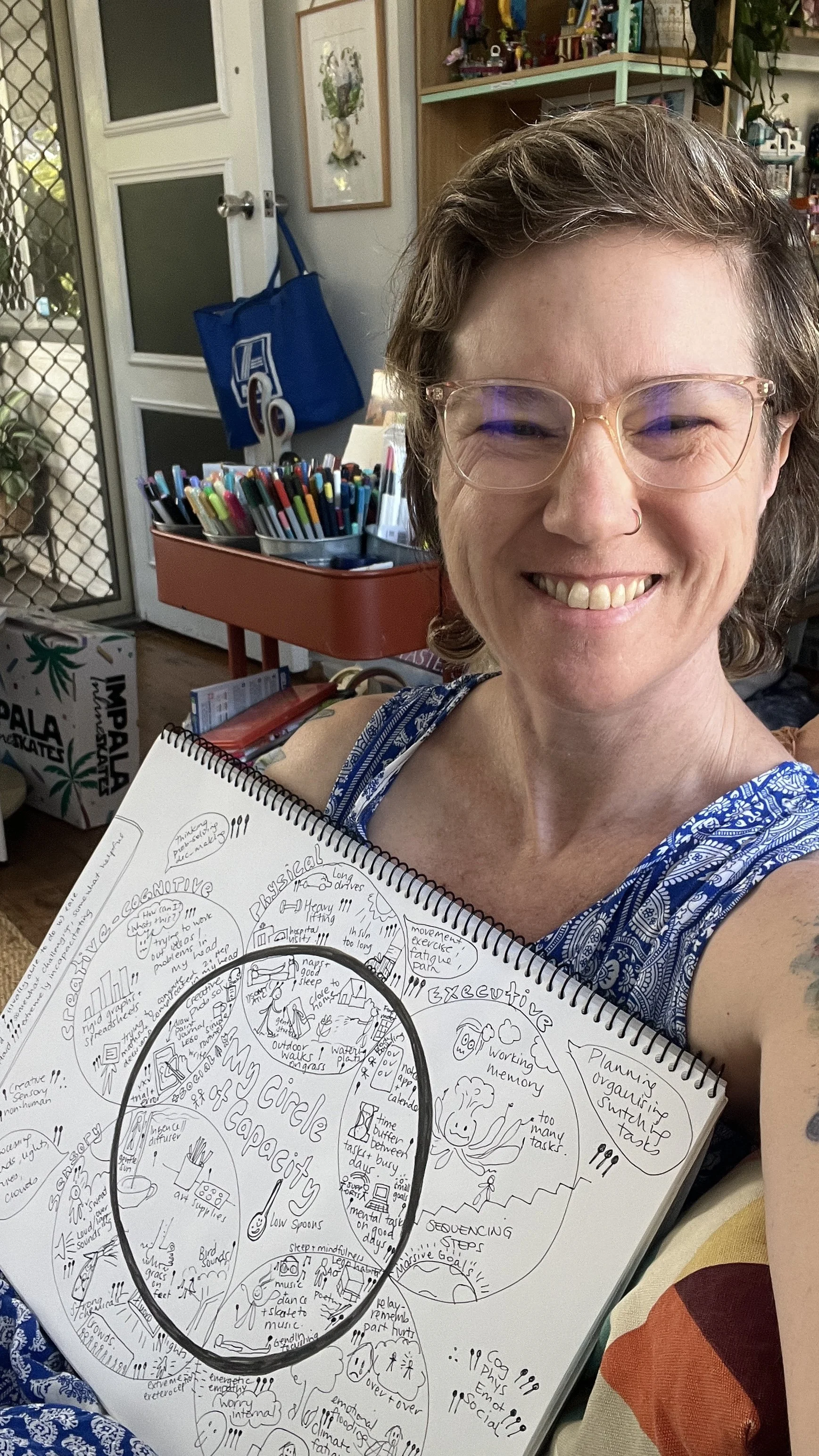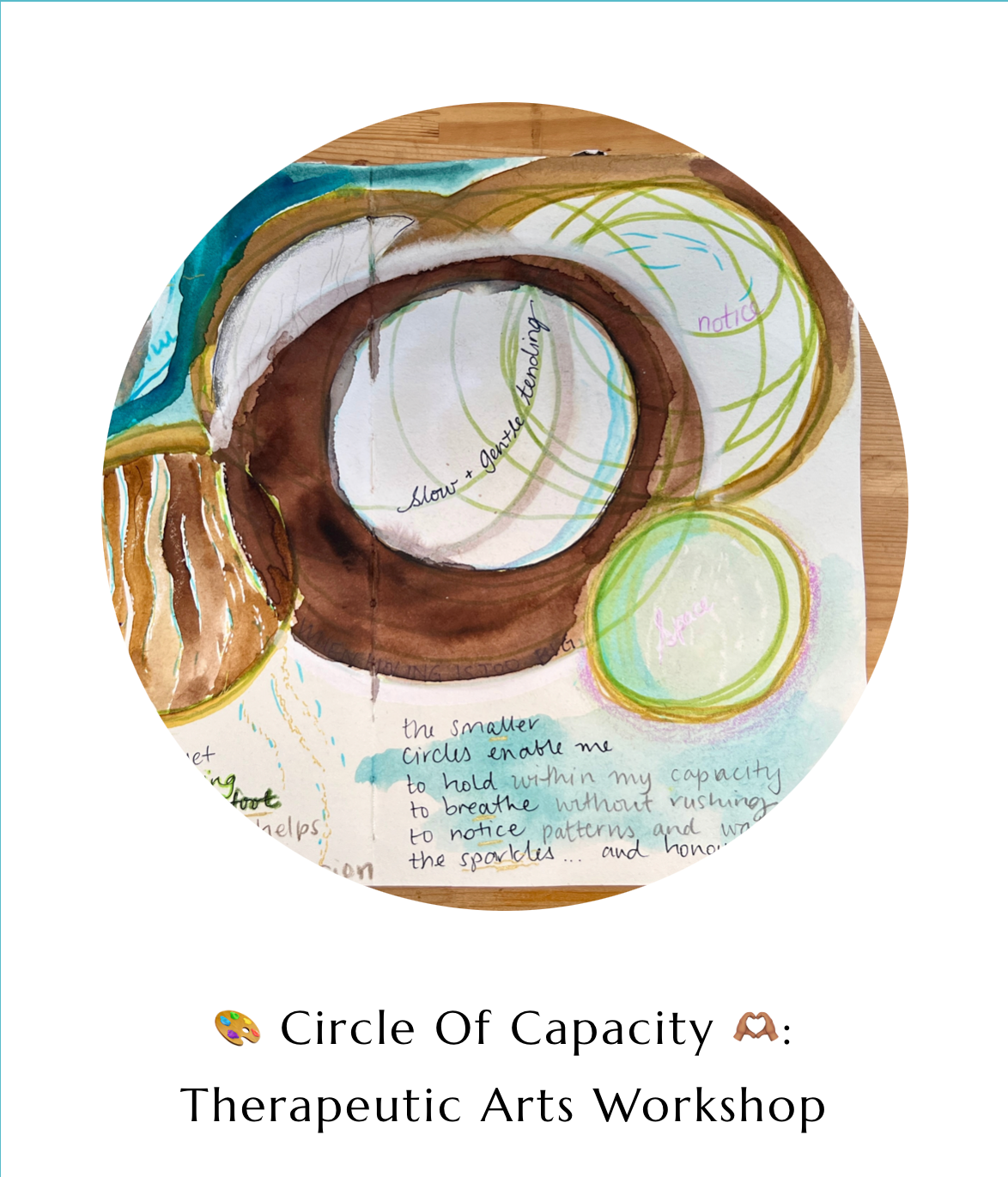Shift Beyond Tolerating ~ the Circle of Capacity 🌻🟡💫
Drawing my Circle of Capacity using nourishing therapeutic arts processess
Hi lovely,
In this month’s blog post, I’m exploring some important ways that sensitive and neurodivergent people might shift beyond the ‘Window of Tolerance’ model, and lean into their Circle of Capacity, using therapeutic arts as an alternative, complimentary wellbeing process.
Window of Tolerance - via Neurodivergent lived experience
As a late-diagnosed Autistic-ADHD woman in therapy for anxiety for over 2 decades; I’ve explored a huge range of therapeutic concepts and psychological tools, designed for healing and recovery. Before my diagnosis, much of my therapy was aimed at identifying my problematic thoughts and choices, and exploring ways to shift my tolerance and actions around them - in essence, learning to feel the anxiety and push through it into aligned action (a combination of CBT, ACT & mindfulness).
The problem was, many of the cognitive therapeutic reframes didn’t ‘stick’, because the exercises didn’t always accommodate my neurodivergent brain and nervous system, which was already overwhelmed, misunderstood and in desperate need for relief, care and support.
For example, in therapy I would learn intellectual tools to tolerate the intense anxiety about a setting a future boundary - but when I got into the situation in real life, my stress response rose so high, which then piqued my sensory overwhelm, so that I couldn’t access any of the executive cognition I was taught! Now I’m in perimenopause, my working memory has got even worse, so I’m unlikely to remember internal scripts anyway.
It seemed in therapy, I had to consistently lean into my weaknesses to strengthen my skills - which led to a lot of white knuckled practices and failed attempts to become ‘more tolerant’ in stressful situations (when the stress itself took me outside my window of tolerance!). Plus, only focussing on ‘fixing’ my perceived weaknesses, did nothing for my self-esteem or understanding of the need for support underlying my challenges, many of which, were related to my hyper sensitive nervous system.
Introducing the Circle of Capacity
During my art therapy studies, I came across the concept of the ‘Circle of Capacity’ by Cathy Malchiodi. Cathy’s reframe compliments the infamous ‘Window of Tolerance’ method (coined by psychiatry professor Dan Siegel), by expanding our capacity and receptivity to positive, life-affirming mind-body experiences — beyond the endurance of stress. So in short, leaning into more joy, ease, wonder, awe and flow experiences for healing, instead of only digging into the challenges.
For all people, but particularly neurodivergent and late-diagnosed women, capitalism has built a mindset that any emotion-based experiences like joy and wonder are ‘frivolous’, because work and toil are more important.
I have always felt that joy, awe, beauty and wonder and necessary and revolutionary acts of wellbeing advocacy, for people of all ages. It also beautifully connects us to the world we are part of, as co-creators and fellow kin.
This meant that discovering the Circle of Capacity was a really important reframe for me. Rather than only focussing on fixing my ‘broken parts’, I could lean into expanding my capacity for what felt naturally joyous and regulating, and identify areas I do feel capable within, rather than simply tolerating more discomfort when I already felt overwhelmed.
Then, from this softer state, I had more capacity to be able to deal with and approach harder conversations and experiences.
Me drawing in my lounge room, exploring my own Circle of Capacity - a dynamic and changing inquiry.
How Can the Circle of Capacity work for neurodivergent people?
Autistic and ADHD people are wired with interest-based brains. This means we have natural strengths and special interests that light us up, and we want to do more of it. This gives us a therapeutic baseline to work with - working with our interest-strengths can be an access point to positive emotion, enabling us to develop skills and self-awareness in ways that feel meaningful and accessible to us.
The Circle of Capacity enables a positive lens for neurodivergent people to explore aspects of life that may dis-able us. For example, if I know loud noises and planning ahead are super stressful experiences for me (because of my sensory needs and executive functioning challenges), perhaps I can explore which sounds and tools are helpful for me to plan instead? Or if I rely on verbal scripts to communicate in hard conversations, perhaps texting or writing my viewpoint out, is more within my Circle of Capacity than verbal discussion.
For many late-diagnosed Autistics & ADHD’ers, a lifetime of masking to appear neurotypical, means many of us don’t what what our true needs are — because we’ve just been trying to do what society deems is ‘right’ instead. The Circle of Capacity can be an access point to become more aware of when we feel most calm and capable, and expand these traits into other areas of our lives. For example, if I discover I can make decisions better after I’ve had a nap or done some journaling to process a big-feeling, I can then use these as resources for future problems solving. E.g. Journaling about a big conversation before I have it, helps me experience and understand my needs better, so I have a better chance of being able to communicate them.
Visual & kinaesthetic learning can enable Autistic and ADHD brains and bodies to process experiences in more meaningful and embodied ways, than talk/cognitive therapy alone. It’s like we need to experience something as a whole, to understand it from 360 degrees, otherwise we get caught on small details and can’t fully understand or process. In short, true learning happens when it’s both intellectual and felt-sensing - not just one or the other. It’s often the kinaesthetic movement to process a topic or experience - to be inside, through and around it - that helps the learning really stay with us.
Exploring my Circle of Capacity via therapeutic art: Sensory, creative/cognitive, executive functioning, emotional and social
Utilising Art Therapy to process & the Circle of Capacity.
As someone who cannot plan in my head, and has always drawn and doodled my ideas, it made sense to me to really understand the Circle of Capacity, by drawing it. Here’s how I processed it creatively:
I started with a large circle in the middle with a clear, thick boundary — this is my Circle of Capacity.
I then drew other sub-circles half-overlapping like flower petals, to indicate the different ways I process - e.g. Creative, Cognitive, Physical, Executive Fuctioning, Sensory (I could add social circle, but for me, everything is relational, so I wove social into all areas).
Inside the Circle of Capacity boundary, within each sub-circle, I brainstormed all the things that feel easeful for me, relating to that section. For example, in the Sensory circle, things like bare feet on grass, listening to bird song, laying in gentle sunshine, or playing with art supplies, all feel like positive and joyful ways to experience and process my sensory experiences.
In the areas outside my Circle of Capacity, I brainstormed all the experiences that overwhelm my nervous system, relating to that section. For example, things like the sensation of sweating, loud sounds, strong chemical smells and fluoro lights are all things that easily overwhelm my equilibrium, so these are drawn outside my Circle of Capacity.
Finally, I added a ‘Spoons Key’, which references Spoon Theory by Christine Miserandino. This key illustrates the concept of limited energy in individuals with chronic conditions, and shows how each experience affected my ‘spoons.’ Interestingly, all the experiences within my Circle of Capacity only used 1-2 spoons, and everything outside of my Circle of Capacity used 2-3.
Clearly seeing what’s inside my Circle of Capacity via therapeutic drawing, helped me articulate what I am joyfully and easefully capable of, without being thrown off by overwhelm. This drawing now serves as an excellent processing tool and a visual reminder for me whenever I see it, around how I might engage with my life, my needs and my boundaries (visual reminders are very helpful to bolster challenges with executive functioning and working memory!)
Experience a Circle of Capacity Therapeutic Arts Workshop
This month, I’m sharing my Circle of Capacity drawing process online, LIVE & Recorded: PARTICIPATE HERE
🎨 Circle Of Capacity 🫶🏽: Therapeutic Arts Workshop
✨ October 15th @ 10am AEST
In this inner-resource-building workshop, we will redefine our ‘window of tolerance’ into a more caring and attuned ‘Circle of Capacity’ (Malchiodi, 2021), much more aligned to our unique neurodivergent capacity. We will guided to depict shapes and imagery to align with our key values for both personal self-care and professional nourishment.
Join LIVE or access the recording after we’re done.

